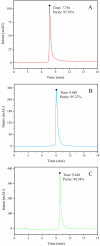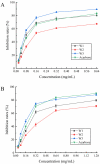Separation of flavonoids with significant biological activity from Acacia mearnsii leaves
- PMID: 36950079
- PMCID: PMC10026372
- DOI: 10.1039/d3ra00209h
Separation of flavonoids with significant biological activity from Acacia mearnsii leaves
Abstract
Acacia mearnsii leaves, which are a rich source of flavonoids, were used to separate and purify myricitrin (W3) and myricetin-3-O-glucoside (W1). Further, the antioxidant and hypoglycemic activities of the two purified flavonoids were evaluated. The flavonoids were separated using solvent partition, macroporous adsorbent resin column, and Sephadex column chromatography, and purified using preparative reverse-phase high-performance liquid chromatography (HPLC). The purified flavonoids were characterized using HPLC, mass spectrometry, and nuclear magnetic resonance methods. A high yield (7.3 mg g-1 of crude extract) of W3 was obtained, with a high purity of 98.4%. Furthermore, the purity of W1 was over 95%. W1 and W3 showed strong antioxidant activity and significantly inhibited α-glucosidase. W3 also demonstrated substantial α-amylase inhibitory capacity. This study indicated that A. mearnsii leaves, which are discarded in significant amounts, can be used as a source of myricitrin, thus providing more adequate material for the production of antioxidants and type II diabetes inhibitors. Hence, A. mearnsii leaves have the potential to create great market economic value and environmental benefits.
This journal is © The Royal Society of Chemistry.
Conflict of interest statement
The authors declare no competing financial interest.
Figures





Similar articles
-
Tannins from Acacia mearnsii De Wild. Bark: Tannin Determination and Biological Activities.Molecules. 2018 Apr 5;23(4):837. doi: 10.3390/molecules23040837. Molecules. 2018. PMID: 29621196 Free PMC article. Review.
-
Analytical Profiling of Proanthocyanidins from Acacia mearnsii Bark and In Vitro Assessment of Antioxidant and Antidiabetic Potential.Molecules. 2018 Nov 6;23(11):2891. doi: 10.3390/molecules23112891. Molecules. 2018. PMID: 30404154 Free PMC article.
-
Effects of In Vitro Digestion on the Content and Biological Activity of Polyphenols from Acacia mearnsii Bark.Molecules. 2018 Jul 20;23(7):1804. doi: 10.3390/molecules23071804. Molecules. 2018. PMID: 30037047 Free PMC article.
-
Preparative isolation of novel antioxidant flavonoids of alfalfa by stop-and-go counter-current chromatography and following on-line liquid chromatography desalination.J Chromatogr A. 2011 Sep 9;1218(36):6191-9. doi: 10.1016/j.chroma.2010.10.092. Epub 2010 Oct 30. J Chromatogr A. 2011. PMID: 21092976
-
Investigation of Enzyme Inhibitory Activities, Antioxidant Activities, and Chemical Properties of Pistacia vera Leaves Using LC-QTOF-MS and RP-HPLC.Iran J Pharm Res. 2022 May 10;21(1):e127033. doi: 10.5812/ijpr-127033. eCollection 2022 Dec. Iran J Pharm Res. 2022. PMID: 36060918 Free PMC article.
Cited by
-
Cistus, Acacia, and Lemon verbena Valorization through Response Surface Methodology: Optimization Studies and Potential Application in the Pharmaceutical and Nutraceutical Industries.Pharmaceuticals (Basel). 2024 May 7;17(5):593. doi: 10.3390/ph17050593. Pharmaceuticals (Basel). 2024. PMID: 38794166 Free PMC article.
-
Characterization of Mineral Composition and Nutritional Value of Acacia Green Pods.Plants (Basel). 2023 Apr 30;12(9):1853. doi: 10.3390/plants12091853. Plants (Basel). 2023. PMID: 37176911 Free PMC article.
-
Research Progress on Hypoglycemic Effects and Molecular Mechanisms of Flavonoids: A Review.Antioxidants (Basel). 2025 Mar 22;14(4):378. doi: 10.3390/antiox14040378. Antioxidants (Basel). 2025. PMID: 40298635 Free PMC article. Review.
References
-
- Silva G. F. Souza E. T. Almeida R. N. et al. . Molecules. 2022;27:970–989. - PubMed
-
- Oliveira G. R. Grasel F. Pinho G. P. et al. . Ind. Crops Prod. 2020;147:112200.
-
- Silva C. E. Quevedo D. M. Jahno V. D. J. Clean. Prod. 2020;264:121632.
LinkOut - more resources
Full Text Sources
Other Literature Sources

